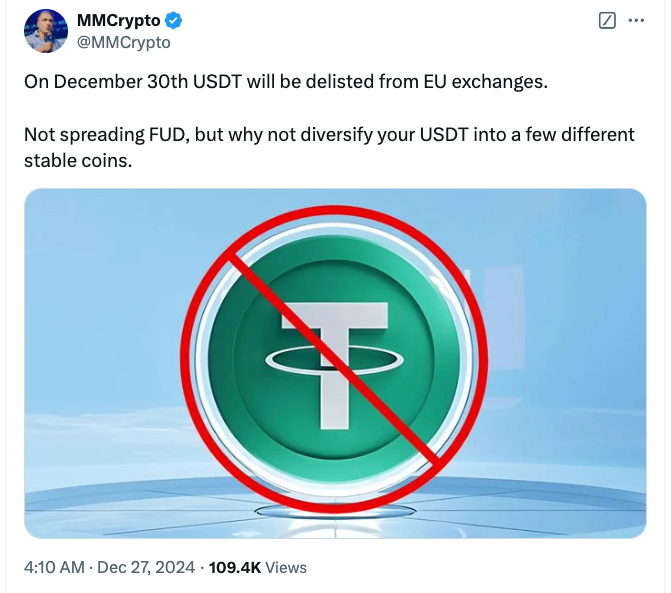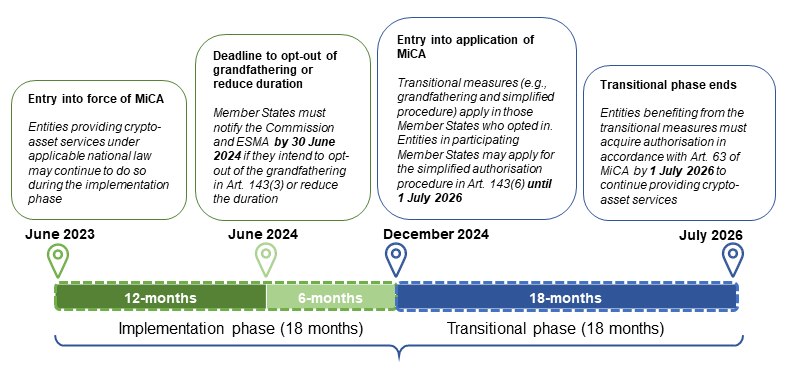The European Union’s cryptocurrency regulations are set to take full effect in just a matter of days, but there’s still a significant amount of uncertainty on Tether’s USDt stablecoin.
United States crypto exchange Coinbase delisted Tether’s USDt in mid-December, citing compliance with the EU’s Markets in Crypto-Assets Regulation (MiCA).
After Coinbase’s USDT delisting, the stablecoin has continued trading across the EU, with many exchanges apparently awaiting more clarity from European authorities on USDT’s compliance with MiCA.
EU regulators have not said whether USDt is compliant with MiCA, but this doesn’t mean stablecoin is not seen as non-compliant in Europe, according to a member of the MiCA Crypto Alliance.
USDt’s fate in Europe: All eyes on MiCA deadline
“No regulators have explicitly stated that USDT isn’t compliant, but this does not mean that it is,” Juan Ignacio Ibañez, a member of the Technical Committee of the MiCA Crypto Alliance, told Cointelegraph.
Addressing exchanges like Binance or Crypto.com continuing USDT trading, Ibañez said there are no reasons for crypto exchanges to delist USDT on the same date as Coinbase.
“Coinbase’s decision may reflect a proactive approach to avoid last-minute compliance risks or regulatory uncertainty, a precautionary approach,” he said.
As the EU’s MiCA is expected to enter full force on Dec. 30, USDT delistings in the EU are still likely to come, Ibañez noted, adding:
“We should look at the Dec. 30 date. The question is whether all exchanges will delist USDT at once, whether it will be progressive or whether some will play a ‘wait-and-see’ game expecting statements from the regulators.”
The “wait-and-see” approach doesn’t make much sense relative to other MiCA requirements, Ibañez said, suggesting that it could entail too much regulatory risk.
Conflicting reports on USDT delistings in the EU
While some publications like Bloomberg said that European crypto exchanges must delist Tether’s USDt by Dec. 30, European regulators have not given such guidance by the time of writing.
In October 2024, the European Securities and Markets Authority (ESMA) — a key supervisor of MiCA compliance — declined to tell Cointelegraph whether USDt was seen as a restricted stablecoin under MiCA.
A spokesperson at ESMA then said that the regulator was working with market participants and other stakeholders to address stablecoin-related issues presented in MiCA.
Online reports suggest that Tether USDt (USDT) will stop trading across Europe after Dec. 30, 2024, as shown in the screenshot below.

Cointelegraph approached ESMA for a comment regarding the USDt status under MiCA but did not receive a response at the time of publication.
As of Dec. 27, USDT trading continues on many crypto exchanges operating in Europe, including Binance EU and Crypto.com, Cointelegraph has learned. The exchanges did not comment on whether they plan to delist USDT in the EU in the near future.
MiCA’s transitional phase ends in July 2026
While MiCA’s implementation phase ends on Dec. 30, 2024, there is also a transitional 18-month phase in MiCA’s total 36-month timeline.
According to official information from ESMA, EU member states will have the option of implementing “transitional measures” that would allow entities already providing crypto asset services under applicable law in their jurisdictions to continue doing so during the transitional phase of MiCA.

Among MiCA transitional measures, ESMA mentioned the “grandfathering” clause. The clause allows entities providing crypto asset services in accordance with national applicable laws before Dec. 30, 2024, to continue to do so until July 1, 2026, or until they are granted or refused a MiCA authorization.
The other transitional measure is a simplified authorization procedure, which targets entities already authorized under national applicable law on Dec. 30 to provide crypto asset services, it said.
“During the transitional phase, a mix of regimes will coexist across member states, which may result in disparate levels of protection for consumers of crypto-asset services,” ESMA noted.
The regulator also provided a list of grandfathering periods decided by member states under MiCA. According to the document, 10 member states and European Economic Area countries — including France and Estonia — will have an 18-month grandfathering period.

Eight other EU jurisdictions, such as Austria, Greece and Spain, will have a 12-month transition period, while six more — like the Netherlands — will have a six-month grandfathering period.
Source: https://cointelegraph.com/news/tether-usdt-eu-mica-compliance-uncertainty



